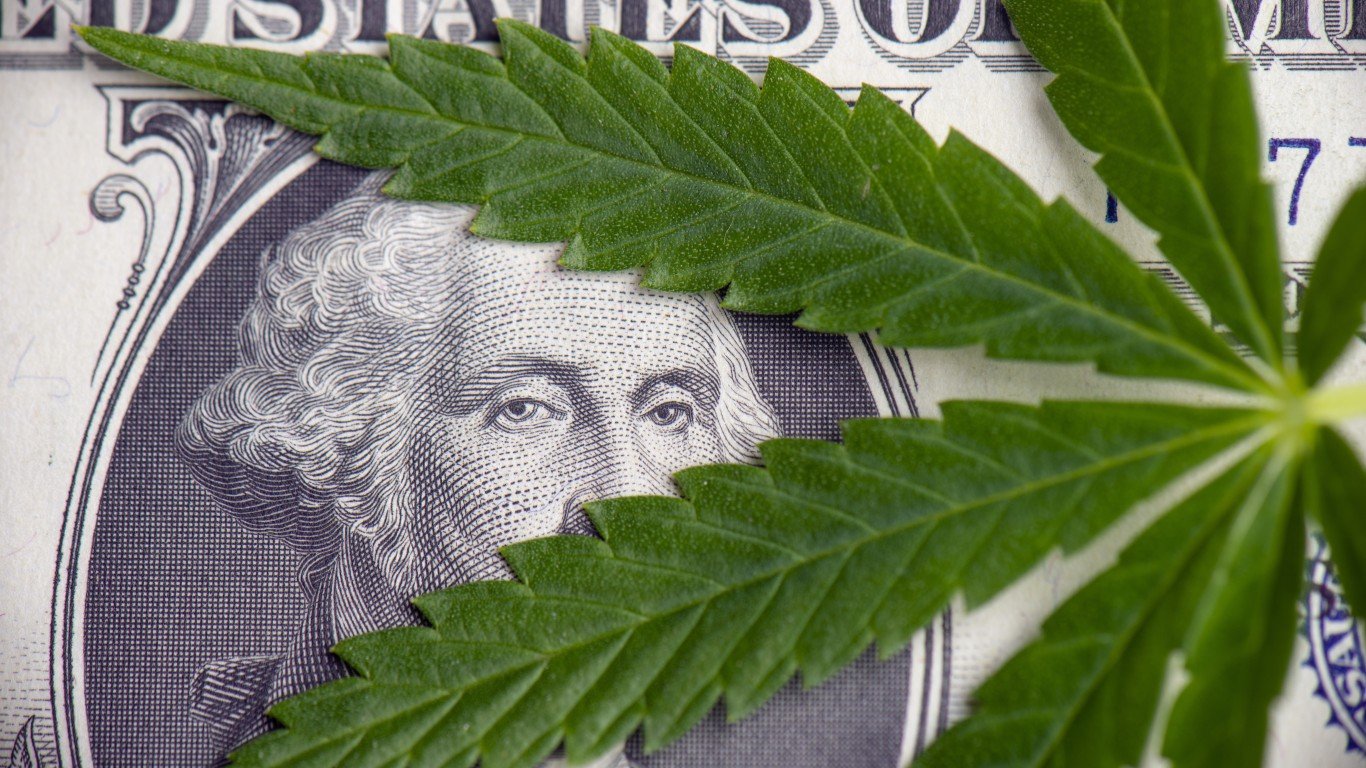

When Canada opened for business with legal recreational marijuana sales in October of 2018, Aurora Cannabis Inc. (NYSE: ACB) posted an all-time high of around $12.53 a share. Since then, the stock has fallen to a new all-time low of $1.65. And that was just last week.
For many other Canadian cannabis stocks, 2019 was also a miserable year. Tilray Inc. (NASDAQ: TLRY), Canopy Growth Corp. (NYSE: CGC), Cronos Group Inc. (NASDAQ: CRON), CannTrust Holdings Inc. (NYSE: CTST) and OrganiGram Holdings Inc. (NASDAQ: OGI) traded down on the year by 75.69%, 27.07%, 32.18%, 82.14% and 41.4%, respectively. Aurora stock lost nearly 59% last year.
Investors of Aurora Cannabis, like investors everywhere, are an impatient lot. Wall Street expects profits, and none of these companies is anywhere near profitability. Last year was not one for patience. The S&P 500 index gained around 29% last year. The stock market offered plenty of other opportunities for profit.
Canadian Cannabis Regulators Didn’t Help
While investors often complain that regulations hurt profits, in the case of marijuana stocks that complaint is justified. The inability of Canada’s regulatory body for cannabis sales, Health Canada, to handle the volume of applications from growers like Aurora or the demand from retailers hampered legal sales. Too few sales outlets crimped demand and left growers with a lot of product that had nowhere to go.
In Ontario, Canada’s highest population province, only about two dozen stores were open a full year after sales began. The provincial government has been accused of slow-walking the licensing process with its lottery system for picking license winners.
Health Canada also failed to move quickly enough to license derivative products like edibles, vapes, infused beverages, topicals, tinctures and concentrates. These high-margin products were not available until late in the year. The sale of derivatives was expected to boost revenues and profits and to keep investors buying stock in Canada’s cannabis companies.
It’s worth noting that while Canada exports more cannabis than any other country, none of its exports goes to the U.S. recreational markets. Both Tilray and Canopy Growth have government-approved contracts with a few U.S. universities to supply cannabis for research purposes. This situation is unlikely to change until the U.S. federal government lifts its classification of marijuana as a dangerous (Schedule I) drug in the same bucket as heroin and cocaine.
Cultivators and Investors May Have Been Counting Too Much on the United States
Even though the U.S. market for cannabis and its derivative products is not open to Canadian firms like Aurora, what happens in the United States affects how investors look at the market everywhere. Lacking federal legalization of marijuana for either medical or recreational use means that a company wanting to grow marijuana must figure out how to make money in each state where sales are legal.
In the United States, high state and local taxes also took a toll on sales. In California, which kicked off legal sales in January of 2018, there were 873 licensed retail businesses in operation, compared with more than three times that many illicit storefronts and delivery services.
Not only were there more illegal than legal businesses, the non-licensed retailers could sell their product for less because they did not have to meet expenses like quality testing or pay state and local taxes.
The Federation of Tax Administrators, a professional organization of state tax collection agencies, has produced a list of the marijuana tax rates in the 11 states where recreational sales are allowed. The following chart provides details on the legal U.S. recreational marijuana market in 2018, the last full year for which data is available.
| Legislation Passed | First Sales | Statewide Sales 2018 | Tax Revenue 2018 | |
|---|---|---|---|---|
| Colorado | Nov-12 | Jan-14 | $1.55 billion | $254.30 million |
| Washington | Nov-12 | Jul-14 | $1.00 billion | $376.10 million |
| Oregon | Nov-14 | Oct-15 | $777.60 million | $94.23 million |
| Alaska | Nov-14 | Oct-16 | $39.50 million | $15.70 million |
| Nevada | Nov-16 | Jan-17 | $102.70 million | $86.90 million |
| California | Nov-16 | Jan-18 | $2.75 billion | $345.20 million |
| Massachusetts | Nov-16 | Nov-18 | $106.00 million | $678,100 |
| Maine | Nov-16 | n/a | n/a | n/a |
| Vermont | Jan-18 | n/a | n/a | n/a |
| Michigan | Nov-18 | Dec-19 | n/a | n/a |
| Illinois | May-19 | Jan-20 | n/a | n/a |
Aurora Hasn’t Helped Itself Much, Either
Aurora has, among other things, a cash problem. In its first quarter for fiscal 2020 (ending September 2019), the company reported cash flow from operations of negative $71.6 million, a larger drain than in any of the previous three quarters. The quarter’s operating loss totaled $57.7 million.
All that bad news, and more, comes despite hiring Nelson Peltz as a “strategic advisor” in March 2019. Peltz’s hedge fund, Trian Fund Management, has taken on some tough proxy fights and managed to win their share. One thing his appointment at Aurora should have brought is some financial discipline, but last year’s results showed no such restraint.
Even Peltz likely could not have stopped Aurora’s spate of acquisitions that culminated in July of 2018 with a C$3.2 billion all-stock deal for MedReLeaf. The acquisition brought with it 164 acres of growing land, including a 69-acre plot with a building already on it. The company planned to convert the facility to an indoor growing space.
In January of 2020, Aurora put that greenhouse up for sale for C$17 million. Aurora also stopped work on a major growing facility in Alberta and another in Denmark.
The revenue estimate for fiscal 2020 is $294 million, down from an earlier top of $694 million. Earnings per share estimates also have plummeted, from a high of $0.14 to the current consensus calling for a loss of $0.12 a share.
Things are expected to improve in fiscal 2021 as revenue rises to $556.8 million, and even better to $842.3 million in fiscal 2022. Predicting what 2020 will bring is hard enough, so those estimates should be taken with a large grain of salt.
Price targets on the stock have plunged as well. The current target is $5.53, compared to a current price of around $1.75. That pencils out to an implied gain of more than 200%. As unlikely as that may seem, on the first trading day of 2020, the price target was a dollar higher.
Looking ahead to the rest of this year, there is no sign of a white knight riding up to save the day in the way that Constellation Brands Inc. (NYSE: STZ) and Altria Inc. (NYSE: MO) invested huge sums in Canopy Growth and Cronos, respectively, while Molson Coors (NYSE: TAP) formed a joint venture with Hexo Corp. (NYSE: HEXO) back in the last half of 2018. The effects of those investments on share prices lasted less than six months.
Maybe the next time will be different. Then again, maybe not. Since December, the most positive analyst to weigh in rates Aurora stock a Hold. Two others downgraded the stock from the equivalent of Neutral to Sell, another downgraded Aurora to a Hold and the last clung to a Sell rating.
Sponsored: Want to Retire Early? Here’s a Great First Step
Want retirement to come a few years earlier than you’d planned? Or are you ready to retire now, but want an extra set of eyes on your finances?
Now you can speak with up to 3 financial experts in your area for FREE. By simply clicking here you can begin to match with financial professionals who can help you build your plan to retire early. And the best part? The first conversation with them is free.
Click here to match with up to 3 financial pros who would be excited to help you make financial decisions.
Thank you for reading! Have some feedback for us?
Contact the 24/7 Wall St. editorial team.



